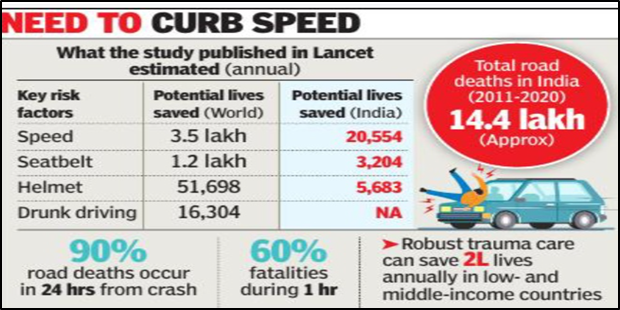In News:
- According to a recent report published in the medical journal Lancet, India could have prevented at least 29,400 road deaths (nearly 20% of total road fatalities) in 2018 if it had implemented interventions focusing on speeding, drunk driving, seat belt and helmet use.
- The report was released ahead of the UN General Assembly's (UNGA) high-level meeting on Global Road Safety, at which member countries pledged to reduce road deaths and injuries by half by 2030.
What’s in today’s article:
- UNGA adopts resolution on improving global road safety
- High-Level Meeting on Global Road Safety (Background, about the meeting)
- News Summary (Findings of the Lancet report)
UNGA adopts resolution on improving global road safety:
- The UNGA adopted a new resolution on road safety in 2020.
- The UNGA recognizes the role of the Department of Safety and Security (UNDSS) in implementing the UN Road Safety Strategy for reducing road traffic crashes and fatalities.
- The UNDSS was formally established in 2005, to support and enable the effective conduct of UN activities by ensuring a coherent, effective and timely response to all security-related threats and other emergencies
- The resolution also includes the following key provisions:
- Endorses the Stockholm Declaration (adopted in 2020, it connects road safety to the implementation of the 2030 Agenda for Sustainable Development).
- Proclaims Road Safety 2021 - 2030 (a Second Decade of Action), with a goal to reduce deaths and injuries by 50% by 2030.
- This is an adjustment to the Sustainable Development Goal (SDG) 3.6 - halving the number of global deaths and injuries from road traffic accidents by 2020.
- Agrees to convene a high-level meeting of the UNGA on road safety by the end of 2022.
High-Level Meeting on Global Road Safety (June 30 - July 1, 2022):
- Background:
- Every year, nearly 1.3 million people are killed in road accidents, which are the leading cause of death among children and young adults.
- Aside from the human suffering caused by road traffic injuries, they also impose a significant economic burden on victims and their families, both in terms of treatment costs for the injured and lost productivity for those killed or disabled.
- More broadly, road traffic injuries have a significant impact on national economies, costing countries 3% of their annual GDP.
- As a result, SDG target 3.6 called for halving the number of road traffic fatalities and serious injuries by 2030.
- Ensured transportation system safety is also directly related to SDG targets on sustainable cities and communities (SDG 11) and climate action (SDG 13).
- About the High-level Meeting of the UNGA:
- The High-level Meeting of the General Assembly on improving global road safety shall be held in New York in 2022.
- The overall theme of the High-level Meeting will be “The 2030 horizon for road safety: securing a decade of action and delivery”.
- It will address gaps and challenges by mobilizing political leadership, promoting multisectoral and multi-stakeholder collaboration in this area and assessing progress toward the SDG road safety-related targets.
News Summary - Findings of the Lancet report:
- Background:
- According to Ministry of Road Transport and Highways (MoRT&H) statistics, despite several years of policymaking to improve road safety, India remains one of the worst-performing countries in this area, with 1,47,913 people killed in road traffic accidents in 2017.
- The National Crime Records Bureau (NCRB) figure for the same year is 1,50,093 road accident deaths.
- Furthermore, India's data on road crash mortality is considered an undercount and the Global Burden of Disease report for 2017 estimates 2,18,876 deaths.
- The persistently high annual death toll brings into question the country’s ability to meet SDG 3.6.
- Key highlights of the Lancet report:
- Every year, approximately 14 lakh people are killed and nearly 5 crores are injured in traffic accidents worldwide.
- More than half of those killed are pedestrians, cyclists, and motorcyclists.
- Low and middle-income countries (LMIC) bear the greatest burden of road fatalities and injuries, with high economic costs ranging from 3 - 5% of GDP in 2014.
- In 2019, India amended its motor vehicle law, but its implementation by state governments is inconsistent and incomplete.
- The Motor Vehicles Act established a National Road Safety Board with advisory powers to reform road safety.
- Indian state governments continue to prioritize user behavior (drivers and other road users), education and uneven enforcement.
- Low priority is given to structural changes such as raising engineering standards for roads, signage and signals, training for scientific accident investigation, improving policing skills, etc.
- According to the MoRT&H, rural areas accounted for more than 65% of those killed in road accidents in 2019.
- However, the death rate in densely populated urban areas (32.9%) suggests that better engineering and enforcement can easily reduce fatalities in the current decade.

- Proposals for India:
- The report proposes that India and other countries could cut accident-related deaths by 25 to 40%.
- This is based on evidence that preventive interventions produce good outcomes when applied to four well-known risk factors - high speed, driving under the influence of alcohol, not using proper helmets, not wearing seat-belts and not using child restraints.
- Major interventions in India, first proposed by the Sundar Committee (2007) and ordered by the Supreme Court (S. Rajasekaran vs Union of India), needs immediate implementation.
- The measures include establishing a centralized national body for road safety and establishing decentralized responsibility at the district level.
- Recently, the National Road Safety Board Rules, 2021, call for the formation of technical working groups to address issues such as crash investigation and forensics, which is a positive beginning.










